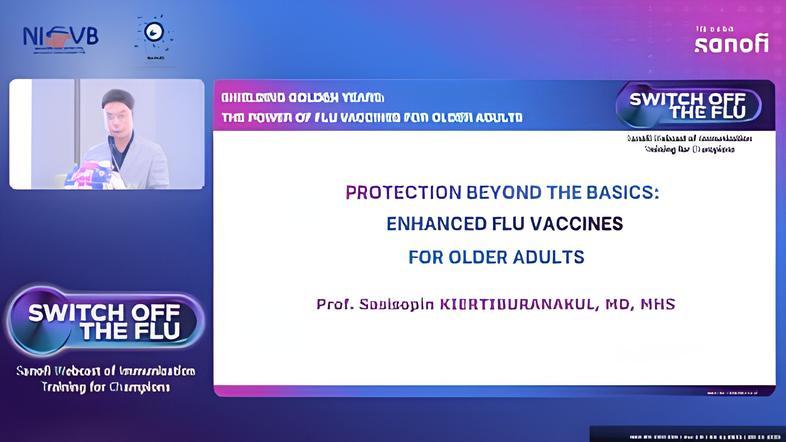COMING SOON
Frequently Asked Questions
COMING SOON
Browse through medical articles

Switch Off Flu Highlights
May 2025
Here's the key highlights from the webinar event last May 6, 2025 - Safeguarding High-risk Groups: The Importance of Flu Vaccination and Effective Communication

Understanding the Influenza Burden in the Philippines
May 2025
Influenza is more than just a respiratory disease and can wreck havoc across major organ systems that impact body, leading to complications. Influenza infection resulted in 8 times increased risk of stroke and 10 times increased risk of heart attack.
Browse through on-demand medical videos

Protection Beyond the Basics: Enhanced Flu Vaccines for Older Adults
While any flu vaccine offers meaningful protection for older adults against severe outcomes, enhanced formulations (high-dose, adjuvanted, or recombinant) are preferred when available due to their superior protective efficacy in this vulnerable population. This evidence-based recommendation applies in countries where these enhanced vaccine options can be accessed for elderly patients

Flu in the Golden Years: A Regional Wake-up Call
In Vietnam, annual influenza hospitalizations among the elderly are 154% higher, and mortality rates 700% higher than in adults aged 50-64. Yet vaccination coverage in those 65 and older remains just 5.55%, well below the WHO target of 75%.

BEYOND THE COUGH: THE DEVASTATING IMPACT OF FLU ON SENIORS
Older adults are most vulnerable to severe influenza outcomes due to aging immune response, frailty, and comorbidities. Flu Infection worsens chronic conditions, raising risks of hospitalization and death. Influenza vaccination should be part of standard care for the elderly, especially those with chronic diseases.

Webinar: Safeguarding High-risk Groups - The Importance of Flu Vaccination and Effective Communication
May 2025
The "Switch Flu Webinar" emphasized the importance of influenza vaccination, particularly for high-risk groups such as the elderly and those with chronic conditions.

From Lab to Jab: The Journey of Vaccine Creation
March 2025
Sanofi has been committed to developing and delivering innovative vaccines for over 100 years, contributing to global health protection.


Panel Discussion on Vaccination and the Philippine Health Systems
February 2024
RealTALK: Vaccine Expert Dr. Rontgene Solante

Influenza Vaccination After Myocardial Infarction (IAMI)
December 2023
Are you aware that contracting the flu may heighten your chances of experiencing a heart attack?
Listen through medical discussions
COMING SOON
Browse through different medical cources
COMING SOON
Explore upcoming medical events

Safeguarding High-Risk Groups: The Importance of Flu Vaccination and Effective Communication
April 2025
Webinar discussion on the importance of flu vaccination and effective communication

Vaccination in Pregnancy: An Essential Component of Antenatal Care
April 2025
Webinar discussion on Vaccination in Pregnancy: an essential component of antenatal care
Explore downloadable medical resources
For General Inquires – Contact us
Adverse events & product safety
If you experience any adverse event, i.e., any unfavorable and unintended sign (an abnormal laboratory finding), symptom, or disease temporarily associated with the use of a medical product, please email it to PV.Philippines@sanofi.com
To report a product technical complaint, please contact our Quality Affairs team:
- Voicemail (non-business hours): +632-8859-5555 extension #1
- Email: Philippines.PTC@sanofi.com
For Data Privacy requests and concerns:
Sanofi General Medicines (under sanofi-aventis Philippines, Inc.) and Sanofi Vaccines (under Sanofi Pasteur, Inc.): OneTrust
For General Inquires – Contact us
Adverse events & product safety
If you experience any adverse event, i.e., any unfavorable and unintended sign (an abnormal laboratory finding), symptom, or disease temporarily associated with the use of a medical product, please email it to PV.Philippines@sanofi.com
To report a product technical complaint, please contact our Quality Affairs team:
- Voicemail (non-business hours): +632-8859-5555 extension #1
- Email: Philippines.PTC@sanofi.com
For Data Privacy requests and concerns:
Sanofi General Medicines (under sanofi-aventis Philippines, Inc.) and Sanofi Vaccines (under Sanofi Pasteur, Inc.): OneTrust
For General Inquires – Contact us
Adverse events & product safety
If you experience any adverse event, i.e., any unfavorable and unintended sign (an abnormal laboratory finding), symptom, or disease temporarily associated with the use of a medical product, please email it to PV.Philippines@sanofi.com
To report a product technical complaint, please contact our Quality Affairs team:
- Voicemail (non-business hours): +632-8859-5555 extension #1
- Email: Philippines.PTC@sanofi.com
For Data Privacy requests and concerns:
Sanofi General Medicines (under sanofi-aventis Philippines, Inc.) and Sanofi Vaccines (under Sanofi Pasteur, Inc.): OneTrust

